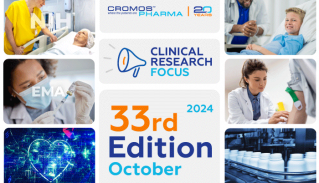
Cromos Pharma Committed to Patient Centricity in Clinical Trials
Over the last few years, patient centricity has moved from buzzword to an imperative. Sponsors are now increasingly willing to offer a patient centric approach to studies. However, there remains some confusion over what this means and how to implement it. In this article Cromos Pharma looks at some of the strategies that can be employed to promote patient centricity.
What is patient centricity?
Patient centricity is an approach to healthcare that puts patients first, at the center of everything we do. Simply put, patient centricity entails putting the patient at the center of clinical research from start to finish. This involves patient participation in study design, including thoughts on location, monitoring and evaluation. It also includes developing opportunities for meaningful interaction throughout the trial process for patients and caregivers, as well as alleviating their stress & engendering their quality of life.
The patient centric model stands in contrast to the traditional, disease-centered approach where treatments are designed without taking into account what patients want or how they will actually use them.
In the era of personalized medicine and patient-generated data, patient centricity is no longer a nice-to-have but a must for all companies operating in healthcare.
A brief history of patient centricity development
The patient advocacy movement was the source of many of the principles behind patient centric clinical research. For several years, individual patients and representative organizations have pushed for greater respect and protection for patients throughout the drug development process.
Their aim was to ensure that the preferences and concerns of patients were not neglected in research, clinical care, and policymaking.
Today, patient centricity is embraced by many organizations as a core driver of innovation and success. This has been helped along by technological advances such as big data analytics and wearable devices, which empower patients to take an active role in their health and healthcare.
What are the benefits?
The benefits of adopting a patient centric approach are numerous and varied.
- Improved patient recruitment and retention – A patient centricity can help to improve patient recruitment and retention rates by making the clinical trial process more efficient and patient-friendly.
- Greater patient engagement – A patient centric approach can lead to greater engagement from patients, which can improve the quality of data and lead to better outcomes. For the patient it creates a sense of ownership and involvement in clinical research rather than being a “guinea pig”.
- Improved data quality – When patients are more engaged in the clinical trial process, they are more likely to provide accurate and reliable data. This, in turn, can improve the quality of better outcomes.
- Improved patient safety – A patient centric approach can help to improve patient safety by making it easier for patients to report adverse events and ensuring that they are fully informed about the risks and benefits of participating in a clinical trial.
How to take a patient centric approach
A 2020 report by Deloitte identified four pillars that should form the foundation for patient centric clinical research:
- Identify concrete objectives around incorporating the patient perspective into different processes throughout the life cycle and operationalize them.
- Track progress toward delivering key performance indicators (KPIs) and return on investment (ROI).
- Harness digital and data analytics opportunities to engage the patient and collect data on patient outcomes as well as their unmet needs.
- Form deeper collaborations within the industry, with advocacy groups, and clinicians[iii].
Bringing clinical trials to patients
The COVID-19 pandemic resulted in an acceleration of the trend towards decentralized clinical trials and remote monitoring as patients were unable to travel to study sites. Undoubtedly, leveraging digital technologies is a vital part of delivering on the promise of patient centricity. These tools allow us to bring the clinical trial directly to the patient and play an important part in reducing the burden of participation. Digital technologies can also be used to improve the patient experience in other ways for example simplifying and making the informed consent process better.
Cromos Pharma and patient centricity
For Cromos Pharma, patients have always been at the center of what we do and how we do it. We understand the important role the clinical research organization (CRO) plays in promoting patient centricity in clinical trials. As an international CRO, patient centric clinical research involves creating meaningful engagement with patients throughout the entire trial from design to execution.
We aim to understand what the patient wants before, during and after the trial. We can address key challenges around patient recruitment by putting forward methods to identify, engage and support patients. By understanding our patients, we can assess how best to reduce the burden of participation e.g., how many site visits are preferrable, how far are patients willing to travel and what do they expect from their experience. We can identify patient-specific concerns that have an impact on recruitment, compliance, and retention. Here are some of the key elements we use to inform our approach:
- Patient centricity at the heart of all we do: From CEO to junior CRA we know that patients are the most important part of our work.
- Understanding the individual patient’s experience: From the number of hospital visits to number of blood draws, understanding how each part of the clinical trial process affects each patient is key to designing a better patient experience.
- Using technology to improve the trial experience: Being patient-centric means evolving processes alongside technological developments. This means upskilling staff, adapting to new ways of working and implementing technologies to increase engagement with patients.
- Providing clear information to patients: Clear communication is central to improving the trial experience. This means looking at documentation to ensure it presents information in an accessible manner. It also means moving towards multimedia content and forms of eConsent.
To conclude, there is a growing focus on patient centricity in clinical trials, as more and more stakeholders recognize the importance of putting patient groups first. By incorporating patient centricity approaches, we can improve the quality and efficiency of our research while also improving the overall patient engagement & advocacy in life science research.






























